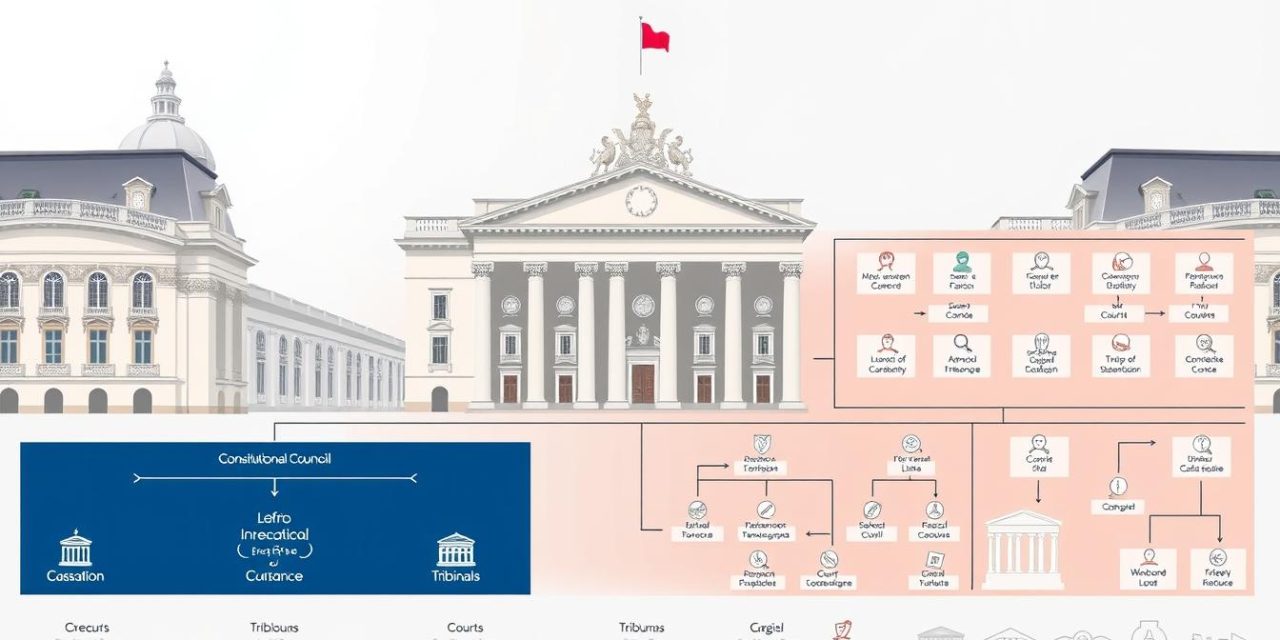Welcome! If you live, work, or run a business in France, you’ve likely encountered its rules and regulations. This system of rules is the backbone of daily life and commerce. It’s not just for lawyers. Knowing how it works is practical for everyone.
This structure is built from many parts. It includes written statutes, court decisions, and administrative guidelines. These elements work together to define rights and responsibilities. The principles behind them aim for order and fairness.
France’s approach has deep historical roots. It has evolved over time, shaped by social change and a strong commitment to democratic values. This evolution makes the system unique, especially its civil law tradition.
Whether you’re in business, healthcare, or environmental protection, these rules apply. They create a predictable environment. This guide will help you understand this essential process.
Table of Contents
Key Takeaways
- The legal framework in France is a comprehensive system governing many aspects of life.
- Understanding this structure is crucial for individuals, businesses, and organizations.
- It is composed of statutes, regulations, case law, and administrative guidelines.
- France’s system is rooted in a civil law tradition and has evolved over time.
- The framework applies across various sectors, from business to public services.
- National laws interact with international obligations within this structure.
- Grasping these concepts is practical knowledge, not just for legal experts.
Introduction to the Legal Framework in France
The French approach to defining rights and responsibilities is rooted in a specific, codified tradition. This entire system provides the structure for how individuals, businesses, and the government interact. It’s designed to create order and predictability for everyone.
This structure is built from several key parts working together. It includes the Constitution, laws passed by Parliament, and detailed regulations. Judicial decisions also help interpret these rules.
France’s system differs from those in many other countries, especially common law nations. Here, written codes are primary. Understanding this distinction is crucial for proper application and compliance.
The framework serves essential purposes:
- Protecting fundamental rights
- Establishing clear rules for commerce
- Providing a fair dispute resolution process
- Ensuring accountability for public authorities
What is a Legal Framework?
Every organized society relies on a system of laws and regulations to function smoothly. This structure defines what people can and cannot do. It creates order and predictability for everyone.
Think of it as society’s rulebook. It includes written statutes, court decisions, and administrative guidelines. These elements work together to protect rights and establish responsibilities.
The main parts of this structure include:
- Written laws passed by government bodies
- Regulations created by agencies
- Court decisions that interpret the rules
- Constitutional principles
This comprehensive system ensures fairness and consistency. It helps resolve disputes through established processes. People and businesses can plan with confidence.
The structure evolves over time. It adapts to social changes and new technologies. This keeps the rules relevant to modern life.
From employment to consumer protection, these guidelines touch daily activities. They create a stable environment where everyone understands their place.
Key Elements of a Legal Framework
Think of a country’s rulebook as a layered structure, with each level playing a specific role. These different parts work together to create a complete and functional system.
This legal framework isn’t just one big book of laws. It’s a collection of different types of rules and guidance.

- Statutes: These are the primary laws passed by a parliament. They set out broad principles.
- Regulations: Government agencies create detailed administrative regulations. They explain how to apply the statutes in real-life situations.
- Case Law: Court decisions in specific cases interpret the rules. These interpretations guide future rulings.
- Guidelines: Public authorities issue practical instructions. This helps ensure a consistent application of the law.
Each element supports the others. Statutes provide the foundation. Regulations add the specifics. Courts resolve disputes and clarify meaning through their process.
Together, they form a dynamic and comprehensive system that can adapt to new challenges. This multi-layered approach makes the entire framework both strong and flexible.
The Importance of a Clear and Intelligible Structure
When laws are easy to understand, everyone benefits from greater predictability and fairness. A well-organized structure ensures that people can grasp their rights and responsibilities without needing a law degree.
This clarity creates confidence in the entire system. People can plan their activities knowing what to expect. Businesses can invest with certainty about the rules.
France addresses this through codification. Laws are organized into systematic codes covering different areas. This approach makes the framework more accessible to citizens.
However, maintaining clarity presents challenges. As society evolves, legal texts must balance detail with simplicity. The process of updating laws requires careful attention to these principles.
When the structure becomes unclear, confusion follows. People may unintentionally break rules they don’t understand. This can lead to unnecessary disputes and undermine trust in the system.
A transparent framework promotes voluntary compliance. It reduces enforcement issues and supports the rule of law. These principles are fundamental to a functioning democracy.
Roles of Relevant Legal Systems and Organizations
Many different groups work together to make the rules work in daily life. These organizations each have a specific role. They create, explain, and enforce the rules.
This system ensures everything runs smoothly and fairly. It is a complex but well-organized process.
The French Parliament makes the main laws. It debates and votes on new rules. This is the first step in the legislative process.
Then, government ministries step in. They create detailed regulations. These rules explain how to apply the law in practice.
Courts have a vital role too. They interpret the rules and resolve disputes. This ensures a consistent application of the rules.
Special authorities oversee specific areas. They handle competition, data protection, and environmental management.
| Organization | Primary Function | Key Example |
|---|---|---|
| Parliament | Creates primary legislation | National Assembly |
| Government Ministries | Develops implementing regulations | Ministry of Justice |
| Judicial Courts | Interprets laws, resolves disputes | Court of Cassation |
| Regulatory Authorities | Oversees specific sectors | French Data Protection Authority (CNIL) |
Local governments also play a part. They implement national rules and can create local supplements. This layered approach makes the entire framework effective.
Professional organizations, like bar associations, contribute their expertise. All these groups work together. They bring the legal framework to life for everyone.
National and Local Laws in the French Context
The French system balances uniform national requirements with tailored local provisions to address diverse community needs. This layered approach ensures consistency while allowing flexibility for regional differences.
France operates as a unitary state where national law generally takes precedence. However, local authorities have specific powers to regulate matters within their territories. This creates a comprehensive structure that serves both national interests and local particularities.
| Administrative Level | Regulatory Powers | Key Areas of Authority |
|---|---|---|
| Regions | Economic development, regional planning | Transport, education, environmental policies |
| Departments | Social services, infrastructure | Road maintenance, social welfare, school transport |
| Communes (Municipalities) | Local public services, urban planning | Zoning, local permits, public safety measures |
Practical examples show how this system works. Opening a business requires compliance with national commercial laws plus local zoning regulations. Construction projects must follow both national building codes and municipal planning rules.
Businesses and individuals must understand this multi-level approach. Compliance involves navigating both universal national statutes and specific local requirements. This ensures smooth operations across different French localities.
« Local regulations complement national laws by addressing specific community needs while maintaining overall consistency. »
The coordination between different levels of government creates an effective process. It allows national standards to be adapted to local circumstances. This balanced approach makes the entire system responsive to diverse needs.
International Treaties and Their Impact
France’s commitment to international cooperation shapes its domestic rules significantly. When France agrees to international treaties, these agreements become part of the country’s comprehensive system. This process connects France with other countries through shared principles.
The government follows a specific process to make treaties binding. First, officials negotiate terms with other nations. Then, Parliament reviews and approves major agreements. Once ratified, these international commitments gain force within France’s domestic system.
France honors obligations from various international agreements. Human rights conventions protect fundamental rights. Trade deals create economic opportunities. Environmental accords address global challenges. These treaties often establish standards beyond national legislation.
European Union membership brings additional layers of rules. EU regulations apply directly across member states. Directives require national implementation. Court decisions from European institutions influence domestic law interpretation.
In case of conflicts, treaties generally rank above regular statutes but below constitutional provisions. This hierarchy ensures international commitments are respected while maintaining constitutional supremacy.
Practical examples show how treaties affect daily life. Trade agreements influence product standards. Environmental accords shape waste management. Labor conventions protect worker rights. These international obligations make abstract principles concrete for citizens and businesses.
Electoral Legal Framework in Democratic Processes
The democratic process in France relies on a well-structured electoral system that protects citizens’ fundamental rights. This comprehensive approach ensures fair and transparent elections at all levels of government.
Voting Rights and Constitutional Provisions
France’s Constitution guarantees essential voting rights for all citizens. These include universal suffrage, equal voting power, and secret ballots. The constitutional foundation establishes the basic principles for democratic participation.
Every eligible voter can participate in choosing their representatives. The system ensures that each vote carries equal weight. These constitutional protections form the bedrock of France’s electoral process.
Electoral Regulations and Administrative Rules
Detailed regulations govern how elections are conducted in practice. These rules cover everything from candidate registration to ballot counting. Administrative authorities oversee the entire electoral process.
Political parties play a crucial role within this system. Regulations govern party formation, campaign financing, and media access. Opposition parties receive specific protections to ensure balanced representation.
| Election Type | Governing Authority | Key Regulations | Voting System |
|---|---|---|---|
| Presidential | Constitutional Council | Two-round majority | Direct universal suffrage |
| Parliamentary | Ministry of Interior | Single-member constituencies | Two-round system |
| Municipal | Local authorities | Mixed member proportional | List voting |
| Regional | Regional prefectures | Proportional representation | List system |
Electoral authorities monitor campaigns and resolve disputes. They ensure compliance with all established rules. This careful oversight maintains public trust in the democratic system.
Social and Economic Influences on Legal Regulations
Social movements and economic transformations continuously reshape how France approaches its regulatory landscape. These forces ensure that rules remain relevant to contemporary challenges and public expectations.
Digital innovation provides a clear example of this dynamic process. France has developed comprehensive data protection and e-commerce regulations to address new technological issues. This demonstrates how economic changes drive regulatory updates.

Social contexts also play a crucial role in shaping regulations. Environmental awareness has led to stronger conservation laws. Changing family structures have prompted updates to family codes. These adjustments reflect evolving social values.
Demographic shifts influence how regulations function in different countries. France’s aging population requires adapted healthcare and pension systems. Urbanization demands updated zoning and transportation rules.
The government balances competing interests through this regulatory process. Economic efficiency must align with social equity. Individual freedoms coexist with collective welfare. This balancing act occurs within France’s comprehensive legal framework.
Understanding these influences helps anticipate future regulatory changes. Rules evolve alongside society’s needs and priorities. This dynamic nature makes the system responsive to new challenges.
Case Studies: Business, Environment, and Public Services
Let’s explore how rules work in real life through practical examples from different sectors. These case studies show how abstract principles become practical guidelines for businesses and public institutions.
Seeing these rules in action helps understand their purpose and impact. We’ll look at environmental services and healthcare to see how they operate.
Environmental Compliance and Waste Management
A waste management company provides a clear example of regulatory compliance. This business must follow strict environmental laws at both national and local levels.
The company needs proper licensing for hazardous material handling. Regular reporting to environmental authorities is mandatory. Safety standards protect workers and communities.
Failure to follow these rules leads to serious consequences. Fines and operational shutdowns can occur. This case shows why understanding regulations is crucial for business success.
Public Healthcare and Social Services
France’s healthcare system operates within a comprehensive legal framework. Laws define patient rights and service quality standards. This ensures consistent care across the country.
Healthcare providers must follow specific procedures for treatment and record-keeping. The process balances universal access with cost control. This management approach maintains service quality.
Social services similarly operate under clear guidelines. These rules protect vulnerable populations while ensuring efficient resource use. The system places citizen welfare at its core.
Legal Framework Governing Human Rights and Obligations
The protection of fundamental freedoms forms a cornerstone of France’s democratic identity. This system ensures everyone’s basic rights are respected in daily life and official interactions.
Fundamental Rights and Judicial Oversight
France’s Constitution guarantees essential protections like equality, free speech, and privacy. These principles apply to everyone living in the country.
Courts play a vital role in upholding these rights. The Constitutional Council reviews laws to ensure they respect fundamental freedoms. Administrative courts check government actions for compliance.
Enforcement Mechanisms and Compliance
When rights are violated, several paths exist for resolution. Individuals can bring cases to courts or file complaints with independent authorities.
Oversight bodies like the Defender of Rights investigate allegations of mistreatment. This process helps maintain trust in the system.
These mechanisms create corresponding duties for authorities and businesses. They must operate within boundaries that respect individual freedoms.
Integrating Legal Information from Diverse Sources
Navigating the maze of official documents and regulations requires a systematic approach. Different government bodies publish rules across various platforms. Understanding how these pieces fit together is essential for compliance.
France offers several authoritative sources for accurate legal information. The Légifrance website serves as the official database for statutes and regulations. Regional prefectures provide local implementation details. Professional bodies issue practical guidance for specific sectors.

Staying current demands a proactive process. Subscribe to official newsletters from relevant authorities. Monitor parliamentary debates for upcoming changes. Track court decisions that interpret existing rules.
Legal professionals play a crucial role in this system. Lawyers help interpret complex requirements. Notaries ensure proper documentation. Advisors create compliance strategies tailored to specific needs.
Technology has made information more accessible than ever. Online portals consolidate updates from multiple organizations. Mobile apps provide real-time alerts. Digital tools help track compliance deadlines.
Developing a personal monitoring system transforms this challenge into a manageable routine. Identify key sources for your situation. Set regular review schedules. Maintain organized records of applicable requirements.
Interpreting Legal Issues Within Social Contexts
Understanding how rules apply in real life requires looking beyond the written text to the society they serve. The same regulation can have different meanings depending on social, economic, and cultural factors. This contextual approach helps resolve legal issues more effectively.
French courts and authorities consider these social contexts when interpreting rules. They balance literal text with practical realities and societal values. This process ensures rules remain relevant to changing circumstances.
| Social Context | Rule Application | Interpretation Approach |
|---|---|---|
| Urban vs Rural Areas | Zoning regulations | Adapted to local needs |
| Economic Conditions | Business compliance | Proportional enforcement |
| Cultural Traditions | Family law matters | Sensitive to local customs |
Judges use interpretive principles like legislative intent and social purpose. They consider how rules function in practice, not just on paper. This approach addresses complex issues that simple rule-application might miss.
When planning activities or seeking advice, understanding these contexts is crucial. Effective analysis combines formal knowledge with awareness of social realities. This sophisticated approach leads to better outcomes for everyone involved.
New Legal Frameworks and Emerging Reforms
Modern challenges require contemporary solutions, and France’s regulatory updates demonstrate this adaptive approach. The country continuously refines its governance structures to address evolving social and technological realities.
Recent changes reflect a commitment to modernization across various sectors. This transformation involves both institutional adjustments and technological integration.
Institutional Changes in a Modern Society
France has implemented significant institutional reforms to improve efficiency and accessibility. Digital court systems and simplified administrative procedures represent key advancements.
The government often uses stakeholder consultations when developing new policies. This inclusive process ensures reforms address real-world needs effectively.
| Reform Area | Key Changes | Implementation Date |
|---|---|---|
| Digital Justice | Online court filings and virtual hearings | 2023 |
| Business Registration | Streamlined company formation process | 2022 |
| Environmental Compliance | Enhanced sustainability reporting requirements | 2024 |
Technological Impact on Legal Systems
Technology drives many recent regulatory updates. Artificial intelligence, data privacy, and cybersecurity demand new approaches that traditional rules couldn’t anticipate.
France’s response includes specific legislation for emerging technologies. These measures balance innovation with consumer protection and ethical considerations.
The ongoing evolution shows how governance must adapt to keep pace with societal changes. This dynamic system ensures relevance in a rapidly transforming world.
Practical Applications: Legal Advice and Case Analysis
Real-world application of legal principles transforms abstract concepts into practical solutions. Knowing when to seek professional guidance is crucial for effective problem-solving.
While general information helps understanding, specific situations often require personalized legal advice. Qualified attorneys provide tailored solutions for complex issues.

A systematic approach helps analyze any case effectively. First, identify applicable rules and gather relevant facts. Then evaluate options for resolving disputes.
The system offers multiple paths for conflict resolution. Negotiation works for cooperative parties. Mediation helps when communication breaks down. Formal proceedings address serious legal disputes.
Contracts often specify which rules govern agreements between parties. This clarity helps prevent misunderstandings and provides a clear process for resolving disputes if they arise.
Through careful case analysis, abstract rules become concrete tools. This practical approach turns theoretical knowledge into actionable strategies for real-life challenges.
Conclusion
As we conclude our journey through France’s regulatory landscape, it’s clear that understanding these systems empowers citizens and businesses alike. The comprehensive structure we’ve explored provides essential stability for daily life and commerce.
France’s approach demonstrates how multiple components work together effectively. Constitutional provisions, statutes, regulations, and court decisions form a coherent system. This ensures consistent application of principles across different situations.
Rather than seeing rules as barriers, view them as practical tools that enable fair interactions. They protect fundamental rights while establishing clear responsibilities for everyone. This balanced approach benefits individuals, organizations, and society as a whole.
The process of governance continues to evolve with social changes and new technologies. Staying informed helps navigate requirements successfully. France’s method offers valuable insights for many countries seeking organized, predictable social order.
FAQ
What are the main sources of law in France?
The main sources include the Constitution, codes like the Civil Code, statutes passed by parliament, and regulations from the government. Judicial decisions also help interpret these rules.
How do international treaties affect French law?
Once ratified, treaties become part of the national system and can override conflicting domestic laws. This ensures France meets its international commitments.
What role do administrative authorities play?
These bodies create detailed rules, provide public services, and ensure citizens and organizations follow the established regulations in their daily operations.
Why is the structure of laws so important?
A clear and intelligible structure makes rules easier to understand and follow. It helps everyone know their rights and duties, reducing confusion and disputes.
How are human rights protected within this system?
Fundamental rights are guaranteed by the Constitution and enforced by courts. Specialized organizations also monitor compliance and address violations.
Can local laws differ from national ones?
Yes, regional and local governments can create specific rules on certain matters, as long as they do not conflict with higher-level national statutes.
What happens when new regulations are introduced?
New rules often modernize old systems. They can change how businesses operate, introduce tech solutions, or improve public services to meet current needs.
Where can I find reliable legal information?
A> Official government websites and professional advisors are the best sources. They offer up-to-date and accurate details on statutes and procedures.





